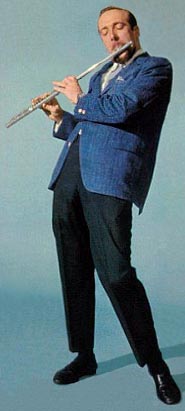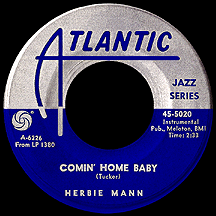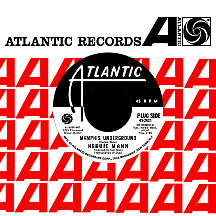HERBIE MANN
Comin' Home Baby
"Comin' Home Baby" is one of those songs that seems to come out great no matter who's performing it...especially if it's an instrumental act. Written by Ben Tucker, bass player for The Dave Bailey Quintet, the original October 1961 recording by drummer Bailey's band featured hot trumpet and sax breaks. When jazz flutist Herbie Mann's cooled down live version began to get noticed the following year, the song really took off and musicians began lining up from here to Grandma's house to take their turn at interpreting this brilliant piece of music.
Mann recorded the song just weeks after the original during an engagement at the Village Gate in New York's Greenwich Village. A skilled band backed Mann: Hagood Hardy on vibraharp, Rudy Collins on drums, Ray Mantilla on conga drum, Chief Bey (eye-catching in his white African robe and pill-box hat) on African drum and Ahmed Abdul-Malik (the bearded one, eyes closed, intent on extracting optimum tones from his standup bass). Tucker, the song's composer, came in as a second bassist, supplying a two minute solo (attacked with the enthusiasm of a lead guitarist) near the end of the eight-and-a-half-minute performance, an impressive opener for Herbie Mann at the Village Gate, his second album for Atlantic Records, which received high praise from critics and was his first major seller. In the summer of 1962, Atlantic made a decision that put Herbie's career into the mainstream: they released an edit of "Comin' Home Baby" on a blue and silver label "Jazz Series" 45. For the first time, he heard his music getting airplay on radio stations beyond the usual jazz outlets.
Brooklyn-born Herbert Jay Solomon first recorded with The Mat Mathews Quintet in 1953 as Herbie Mann, making his solo debut for Bethlehem Records the following year. In December of '54 he played on the sessions for some of Sarah Vaughan's early EmArcy recordings, including the classic "Lullaby of Birdland." He also appeared on sessions supporting Art Blakey, Chet Baker and others during the '50s. In addition to regular performances in New York, he embarked on an extensive tour of 15 African countries in 1960 with an Afro-Cuban group he'd put together. During a tour of Brazil in the summer of 1961, exposure to Latin rhythms embedded the samba and bossa nova beats into his head and the result showed in future work. That same year he signed with Atlantic Records, where he achieved his greatest success.
Once Herbie hit with "Comin' Home Baby" in the summer of 1962, other cover versions began to pop up all over the place. Lyrics were added by Bob Dorough, an established jazz pianist who had been friends with Tucker for some time. Mel Torme's vocal rendition is certainly the definitive one, a top 40 hit in December, a few months after Herbie's breakthrough. For a brief time, Torme drew attention away from the earlier versions; he received two Grammy nominations for the song (in the categories of Best Solo Vocal Performance, Male and Best Rhythm and Blues Recording).
Torme's exuberant intonations notwithstanding, the lasting appeal of "Comin' Home Baby" has been as an instrumental. Quincy Jones gave it an all-out big band arrangement on an early 1963 release, about the same time another band version appeared on the flip side of Kai Winding's top ten hit single "More" (I remember hearing the Winding version off-and-on throughout the '60s, sometimes as a radio or TV commercial track or as a fadeout into top-of-the-hour news on top 40 stations). Surf band The Challengers performed it as a slow-burning organ riff grabber in 1963. Memphis guitarist Travis Wammack reworked the tune as a guitar-and-drum rock track and gave it a new name, "Scratchy" (crediting different songwriters, including Wammack, ethically dubious since it's quite obviously the same song); it hit the national charts in November 1964. Sergio Mendes laid down a piano version of "Comin' Home Baby" and the result was mesmerizing. Hundreds of recordings have been made over the years. I've heard dozens, the vast majority are instrumentals, and so far there hasn't been a bad one in the bunch.

All the while, Herbie Mann's contribution to music continued to advance and proliferate. In 1966, two singles produced by Jimmy Wisner brought him back to the singles charts. The Rufus Thomas song "Philly Dog" (basically the same tune as his hit "The Dog"), was the first, a big New York R&B production akin to what was coming out of the Stax studios in Memphis at the time. A month later, he teamed with West Virginia-born vocalist Tamiko Jones on the theme of the Academy Award-winning French film starring Anouk Aimee, "A Man and a Woman" (composed by Francis Lai and Pierre Barouh with English lyrics by Jerry Keller), which became a standard that is still commonly heard. As the decade neared its end, "Memphis Underground" was another top-selling album for Herbie. The self-penned seven minute title track was pared to 2:50 for the 45 release and in the summer of '69 it became his biggest hit to that point, later securing him the only Grammy nomination of his career (in the category Best Instrumental Jazz Performance by a Small Group or Soloist with Small Group, Seven or Fewer...quite a mouthful and a larger-than-usual list...seven nominees!)
In 1973, Mann voiced his discontent over the way the The National Academy of Recording Arts and Sciences defined jazz when it came to choosing nominees for the Grammy Awards. His objections were not unfounded; NARAS, by its own admission, was judging the music according to artist "intention," leaving people in the industry baffled as to just what that meant or how they could tell what that intention, from one recording to another, might be. He resigned his membership in the Academy. Good for him. Maybe the ambiguousness of definition had something to do with his own breaking down of categorical boundaries; successfully melding his flute expertise with '70s disco techniques, Herbie scored the biggest hit of his career, "Hijack" (written by Fernando Arbex), a top 20 hit in the spring of 1975. "Superman," a Jose Luis Soto song (already a hit for Celi Bee and the Buzzy Bunch in '77) was another perfect-fit Studio 54-type dance floor smash, returning him to the top 40 in early 1979, more than 16 years after "Comin' Home Baby" exposed his fluid flute mastery to the masses. When music's disco phase passed soon after, he continued applying his windwood techniques to various rhythmic strains and ultimately built an extensive, artistically diverse, body of work to be enjoyed ad-infinitum. The overall picture is indisputable: when it comes to jazz flute players, Herbie Mann's name is way, way up at the top of the list.



